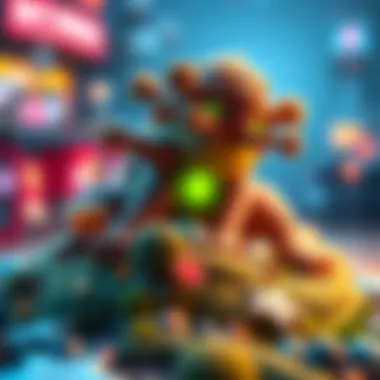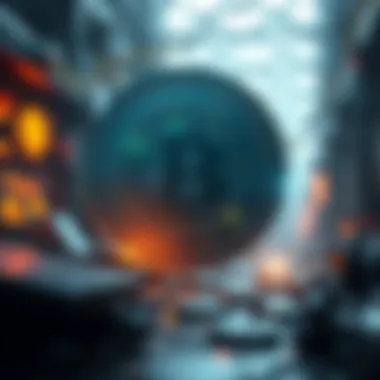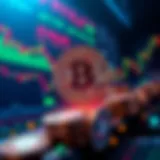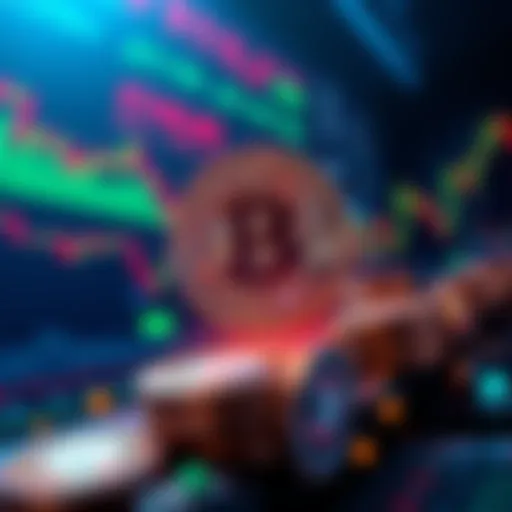Creating NFT Art: A Comprehensive Guide for Artists


Intro
The digital era has brought about a seismic shift in how art is created, shared, and valued. At the forefront of this transformation are Non-Fungible Tokens (NFTs), which allow artists to tokenize their work in a way that was previously unimaginable. This comprehensive guide aims to illuminate the multifaceted journey of creating NFT art, offering insights into both the creative and technological realms.
As artists and creators embark on this innovative path, understanding the foundational elements of blockchain technology and the various cryptocurrencies involved becomes crucial. Beyond the tech speak lies the excitement of engaging with a new market, where digital art can be not only appreciated but also owned in a verifiable manner.
In the sections that follow, we shall delve into the basics of cryptocurrencies and blockchain technology, explore strategies for investment, and unravel the best practices for both creating and selling NFT art. Let's begin this exploration by solidifying our grasp on the underlying tech that fuels the NFT marketplace.
Crypto Fundamentals
Understanding Blockchain Technology
Blockchain technology is the bedrock of NFTs, paving the way for ownership and provenance of digital art. Essentially, a blockchain is a distributed ledger that records transactions across many computers to ensure that this record cannot be altered undetected. This means every digital asset, be it an artwork, music, or a tweet, can be traced back to its origin, preserving its uniqueness and value.
Think of blockchain like a library where every book has a unique reference number, and every time a book is borrowed, it gets logged. Nobody can change the information without everyone knowing, which preserves the integrity of the system. This transparency is a game changer for artists who want to protect their work from copycats and ensure that they receive rightful compensation through royalties on secondary sales.
Cryptocurrency Types and Their Uses
While Bitcoin might be the poster child of the cryptocurrency world, numerous other currencies play a significant role in the NFT ecosystem. Here’s a brief rundown:
- Ethereum: The most widely used blockchain for minting NFTs. Its smart contracts allow for more complex interactions and functionalities.
- Tezos: Known for its eco-friendly consensus mechanism, it's an interesting alternative for artists who are conscious about environmental impacts.
- Flow: Built specifically for games and digital collectibles, Flow focuses on speed and scalability.
When venturing into NFT art, understanding which cryptocurrency is best suited for your needs is key. Choosing a platform that aligns with your creative vision and operational preferences can mean the difference between a successful minting experience and a head-scratching fiasco.
"The beauty of blockchain technology lies not just in its innovation, but in how it empowers individuals to reclaim ownership and authenticity in the digital realm."
Investment Strategies
Long-term vs. Short-term Investing
Artists should weigh their approach to NFT art not just as creators but also as potential investors. The landscape can be likened to the classic dilemma of investing in stocks: Should you hold your digital assets long-term or flip them for quick profits?
- Long-term investing often involves selecting pieces that you believe will appreciate significantly in value. This typically requires a deep understanding of the trends in the NFT market and a keen eye for upcoming artists.
- Short-term investing appeals to those looking for immediate returns. It’s akin to day trading, requiring constant monitoring of market conditions and trends to pounce on promising artworks quickly.
Risk Management in Crypto Investments
Just like in traditional investing, the world of NFTs is not without its risks. Take care to follow some fundamental principles:
- Diversification: Don't put all your eggs in one digital basket. Invest in various artists and styles to mitigate risks.
- Research: Understanding market trends and the backgrounds of the artists can significantly inform your investment decisions.
- Budgeting: Only invest what you can afford to lose, as the NFT market can be highly volatile.
As we wrap up this foundational exploration, it's vital to keep in mind that the journey to successfully create and navigate NFT art demands a careful blend of creativity, technological know-how, and keen investment strategy. Understanding these elements will serve as a springboard for the practical steps that follow in the journey of NFT creation.
Understanding NFTs
In the age of digital innovation, Non-Fungible Tokens (NFTs) have emerged as a pivotal player in the transformation of how we perceive and interact with art. NFTs bring a fundamental shift to digital ownership, enabling creators to tokenize their work in a way that ensures authenticity and originality amidst the limitless expanse of the internet. The concept of NFTs goes beyond merely digitizing art; it encapsulates issues of credibility, provenance, and economic value in a manner that resonates deeply with both artists and investors.
Engaging with the NFT landscape opens doors not just for artists, but for anyone interested in the digital art space. Understanding the nuances behind NFTs can empower creators to fully harness their potential in reaching a global audience. As artists learn to navigate this new terrain, they foster connections that can lead to impactful collaborations and community-building, ultimately fueling the growth of their creative practices.
Defining Non-Fungible Tokens
At its core, a Non-Fungible Token represents a digital asset that is unique and not interchangeable with other tokens. This characteristic of non-fungibility is what sets NFTs apart from cryptocurrencies like Bitcoin or Ethereum, which are fungible and can be traded one-for-one without concern for individual value.
To demystify further, let's break it down:
- Uniqueness: Each NFT has specific information etched into its code that makes it distinct. Think of it as a digital certificate of authenticity for a piece of art.
- Ownership: Utilizing blockchain technology, NFTs provide undeniable proof of ownership. Once an artist mints their work as an NFT, it is stored on the blockchain, making it verifiable and traceable.
- Indivisibility: Unlike cryptocurrencies that can be divided into smaller units, NFTs cannot be split. A piece of digital art, therefore, remains whole and intact – just as a painting exists as a singular entity rather than multiple fractional shares.
NFTs resonate particularly in the realm of digital art, allowing for innovations in presentation and exchange that redefine traditional norms. This technology has not only attracted artists but also collectors, who now have a novel avenue to invest in and support digital creatives.
The Evolution of Digital Art
The trajectory of digital art has been rich and transformative. Initially, digital art was often relegated to the sidelines of mainstream culture, as it struggled against preconceived notions of what constituted ‘real’ art. However, with the advent of technology and the rise of platforms designed for online expression, the doors opened wide for artists to experiment with new mediums and techniques.
- Early Days: In the 1980s and 1990s, artists began exploring digital tools like computer graphics software, but limited visibility and distribution channels kept their work as a niche phenomenon.
- Web 2.0 Revolution: The introduction of social media platforms allowed artists to share their creations far and wide, creating communities around digital art and opening avenues for feedback and collaboration.
- NFT Boom: The introduction of NFTs in recent years marked a seismic shift, formally integrating valuation and ownership into the digital artwork landscape. This innovation has attracted not only established artists but also budding creators eager to test the waters.
The evolution of digital art signifies a broader acceptance and recognition of diverse artistic expressions. As the landscape continues to develop, one can only speculate on the new forms of creativity that will emerge, driven by the foundational changes that NFTs bring to the table.
"The rise of NFTs is carving out a niche for digital artists to truly own their work in a way that's never been possible before."
In essence, understanding NFTs is crucial not just for artists who wish to thrive in a changing environment but also for investors and collectors eager to explore a burgeoning market filled with opportunities.
The Significance of NFTs in Art
The emergence of Non-Fungible Tokens (NFTs) represents a pivotal moment in the evolution of digital art. This technology empowers artists in unprecedented ways, reshaping not only how art is created and valued but also establishing new frameworks for ownership and authenticity. With digital artifacts proliferating in a realm where replication might outnumber the original, NFTs act like a beacon, guiding collectors and artists alike toward a more structured marketplace.
Ultimately, NFTs have become more than just digital badges. They serve as a new form of currency in art, facilitating a direct connection between creators and collectors. This section delves into the two primary facets of this significance: authenticity and ownership alongside their impact on the art market.


Authenticity and Ownership
In the art world, notions of authenticity and ownership are paramount. Before the rise of NFTs, digital artists often wrestled with proving that their work was the original. The internet's ability to duplicate images without loss of quality painted a rather bleak picture, making artists feel like their efforts could vanish into the ether. With NFTs, however, ownership takes on a concrete form. By recording ownership details on blockchain technology, NFTs establish a verifiable and immutable record—akin to a digital certificate of authenticity.
This transformation brings a few significant benefits:
- Verifiable Ownership: Artists and buyers can trace the provenance of an artwork with ease. This leads to greater trust in transactions and reduces the potential for fraud.
- Empowering Artists: Artists no longer have to forfeit rights to their work. They can set terms for resale, fostering a fairer marketplace.
- Variable Supply: Each NFT can be unique or part of a limited series, which can influence both its desirability and its value significantly.
"The uniqueness of each piece of NFT art essentially creates a digital archive that proves the existence and ownership of an artwork, a necessity in today’s art world."
Overall, ownership in the NFT framework is not just about physical possession; it includes the right to sell, exhibit, or even allow the use of the art, something that resonates deeply with creators and collectors alike.
Impact on the Art Market
The art market has seen a seismic shift since NFTs entered the scene. Some might argue it's a bubble, while others see it as a revolution. Regardless, the numbers don’t lie: traditional auction houses and online marketplaces are now catering specifically to NFTs, witnessing sales that reach the millions.
Several important points emerge regarding this newfound impact:
- Diverse Revenue Streams: Artists can now explore various monetization avenues. Through royalties in resales, artists can earn continued income—much different from traditional art sales.
- Global Market Accessibility: Artists, regardless of geographical location, can reach a global audience without needing representation in galleries or physical spaces. This democratization allows for a richer cultural exchange.
- Cultural Shifts: Events like digital art fairs and NFT exhibitions are now commonplace, challenging the traditional notions of how and where art should be displayed.
As these changes ripple through the art ecosystem, it's evident that the significance of NFTs transcends mere technology. They have altered the landscape, encouraging a cultural dialogue that reinvents what it means to own, create, and appreciate art in an increasingly digital world.
By grasping the profound implications and opportunities that NFTs provide, both creatives and enthusiasts can navigate this brave new world of digital art with confidence.
Essential Tools for Creating NFT Art
Creating NFT art delves into the intersection of technology and creativity. The right tools can significantly elevate an artist's ability to produce stunning and original pieces. By choosing the appropriate software and hardware, creators can streamline their workflow and enhance the quality of their artwork. The digital landscape is rich with options, and understanding these essential tools is a fundamental step for anyone looking to make their mark in the NFT space.
Digital Art Software
Digital art software is the backbone of NFT art creation. These applications empower artists to bring their ideas to life, offering a range of features tailored to suit different artistic needs. Consider the following popular tools:
Adobe Creative Suite
Adobe Creative Suite has become a cornerstone in the realm of digital design. Renowned for its robust functionality, Adobe offers tools like Photoshop and Illustrator, which provide optimal flexibility for artists. One key characteristic of Adobe Creative Suite is its versatility—whether you’re designing detailed illustrations or complex graphics, this suite has it all. Artists appreciate the extensive array of brushes, filters, and editing options.
However, affordability can be a hurdle. The subscription-based model might deter emerging artists. Nevertheless, its unique feature is cloud integration, allowing creators to access their work from anywhere. This convenience is a big plus for artists on the go.
Procreate
Procreate stands out primarily for its user-friendly interface. This software is specifically designed for the iPad and has gained skyrocketing popularity among digital artists. Its intuitive controls and high responsiveness make it easy for newcomers to dive in yet powerful enough for seasoned professionals.
A distinctive feature of Procreate is its real-time brush customization. Artists can create and manipulate brushes to achieve desired styles. Plus, supporting various file formats ensures compatibility with multiple NFT platforms. On the flip side, its exclusivity to Apple devices may limit access for some users.
Blender
Blender is often recognized for its 3D modeling capabilities. It's an open-source software that not only allows you to create intricate 3D art but also supports animation and rendering. One of the standout characteristics of Blender is its strong community support and vast library of tutorials, making it easier for users to learn and grow.
Its unique feature is the ability to create complex textures and effects that can elevate NFT artworks significantly. However, its steep learning curve might not be ideal for everyone. Beginners may find themselves overwhelmed by the extensive tools and options available.
Selecting the Right Hardware
While software sets the stage for creating NFT art, the hardware you choose can make a world of difference. Essential hardware for digital artists includes tablets and computers equipped with powerful graphics cards.
Tablets for Digital Art
Tablets tailored for digital drawing, such as the Wacom Cintiq or the iPad Pro, are considered crucial tools for artists. They offer an intuitive approach for drawing, enabling direct engagement with the work. One key characteristic is the ability to use a stylus, providing varying pressure sensitivity, which is essential for nuanced artwork.
Unique to these tablets is their portability, which allows artists to create art anytime, anywhere. However, they can be a bit pricey, and some users may struggle with adjusting to the expressiveness of drawing on a screen as opposed to traditional paper.
Computers and Graphics Cards
High-performance computers and graphics cards are necessary for artists focused on advanced digital creations, especially when working with 3D models or complex layering in their pieces. A robust system can handle intricate rendering without lagging, ensuring that the creative process runs smoothly.
The key characteristic here is processing power. A high-quality graphics card can dramatically improve speed and efficiency during extensive projects. However, the cost of assembling a top-tier setup could be a barrier to entry for some, making it essential to consider budget and needs before investing.
"The tools you choose play a pivotal role in your creative process, impacting both the ease of creation and the quality of your final output."
Creating the Artwork
Creating artwork in the context of NFTs is a pivotal step in translating an artistic vision into a tangible digital form that can be sold or auctioned on various platforms. This process not only involves technical skill but also creative expression. Ensuring that your artwork resonates with potential buyers is key, especially in a crowded marketplace where thousands of NFT pieces are vying for attention. It's important to reflect on how every brushstroke, color choice, and detail contributes to the overall narrative of your piece.
Concept Development
Brainstorming Ideas
Brainstorming serves as the bedrock of concept development. It's where sparks of creativity ignite into potential masterpieces. During this stage, artists gather ideas from various sources—nature, personal experiences, and even art movements. This exploratory process is crucial because it allows one to expand beyond their usual style, leading to unique concepts that can captivate an audience. The dynamic nature of brainstorming encourages flexibility and spontaneity, and that's where the magic often happens.


- Striking a chord with the audience can stem from unexpected places, making brainstorming a beneficial method for creativity.
- A unique feature here is that artists can jot down anything, allowing ideas to flow without immediate judgment or critique, often leading to surprising and innovative outcomes.
However, it doesn't come without challenges. Artists may encounter decision fatigue or self-doubt during this phase, and the sheer volume of ideas can feel overwhelming at times.
Sketching and Prototyping
Once ideas have taken shape, the next step is sketching and prototyping. This phase acts as a bridge between raw ideas and a polished piece. Artists translate their brainstormed concepts into visual forms, generally beginning with quick sketches that do not require high levels of detail.
- Not only does sketching help in visualizing the artwork's layout, but it also allows artists to experiment with different angles, colors, and compositions without any significant commitments.
One of the strengths of this process lies in its flexibility. Sketching encourages iterative refinement, meaning artists can revisit and revise their ideas as they progress. Despite its benefits, it can evoke frustration if the desired outcome doesn't match the initial vision, so patience is key during this part of the artistic journey.
Finalizing the Digital Piece
Color Correction
Moving towards the finishing touches, color correction is a critical step that often gets overlooked. This involves adjusting colors in your digital artwork to ensure they appear as intended across different devices and platforms. The importance of this stage cannot be overstated; colors can evoke emotions and set the tone for an artwork. What might look good in one light can fall flat in another.
- Color correction is, thus, an essential process that enhances the overall appeal of the artwork, making it a popular choice for artists.
- A unique feature of color correction is its ability to transform the mood of a piece—an adjustment in hue or saturation can create a completely different atmosphere, offering significant advantages in achieving the intended impact.
On the flip side, it's easy to overdo it. Artists must tread carefully to avoid unnatural results that detract from the piece's authenticity.
Texture Application
Lastly, texture application adds depth and dimension to digital artwork. It transforms flat images into vibrant works that catch the eye. By layering textures, artists can enhance visual interest and create a sense of realism or abstraction, depending on the desired outcome.
- The key characteristic of texture application is its capacity to convey tactile impressions visually, enriching the viewer's experience.
- By experimenting with various texture styles, artists can attain a unique signature look that differentiates their work from the vast array of NFTs in the market.
Yet, it can come with its own set of challenges, particularly when textures distract from the main subject or make pieces appear overly cluttered. Therefore, balance is crucial.
Minting NFTs
Minting NFTs is at the heart of entering the world of digital ownership, adding significant value not just to the art but to the artist's identity in the digital realm. When we talk about minting, we refer to the process of creating a non-fungible token on a blockchain, thus establishing an artwork's unique identity, authenticity, and traceability. For many artists, this is where their creative endeavor transitions into commerce. However, it’s crucial to navigate this landscape carefully, as various factors can influence not only the cost and feasibility of minting but also the potential impact on your reputation and sales.
Choosing a Blockchain
Ether vs. Other Blockchains
The Ethereum blockchain is widely recognized as the dominant choice for minting NFTs. This popularity stems from its robust smart contract capabilities that allow creators to fully define the terms under which their art can be bought, sold or resold. Ether, as the native cryptocurrency of Ethereum, is instrumental in facilitating these transactions and the whole minting process. It provides advanced functionalities, such as programmed royalties that enable artists to earn a percentage of future sales.
But it's not without competition. Alternatives like Binance Smart Chain, Tezos, and Flow have emerged, each claiming lower transaction fees and faster processing times. The unique feature of these other blockchains can make them appealing, especially for those just testing the waters with NFT art. However, the trade-off often comes at the cost of lower visibility among potential buyers, reducing the market reach.
Gas Fees and Transaction Costs
Gas fees are another critical aspect of minting NFTs. High gas prices on Ethereum can eat into an artist’s profit margin almost like a hungry wolf at the door. These fees vary significantly based on network congestion, and sometimes minting an NFT can cost as much as an average piece of art itself.
While the potential for great returns exists, artists must carefully assess the overall costs of minting on platforms with unstable fee structures. Knowing when to mint, or even choosing less busy times on the blockchain to do so, can be beneficial strategies to save money. The uniqueness of gas fees lies in their dynamic nature – they can rise or fall, allowing savvy creators to time their minting for the best results.
Selecting a Marketplace
Choosing the right marketplace to mint and sell NFTs can make a world of difference.
OpenSea
OpenSea is often considered the go-to platform for many artists. With a user-friendly interface and a vast audience, it facilitates the sale of diverse NFTs, from artwork to virtual real estate. What sets OpenSea apart is its support for multiple blockchains, allowing flexibility in selecting the most suitable option for individual needs.
However, the downside can be the overwhelming number of listings. Standing out among a sea of creators requires strategic promotion and networking. For many artists, this can be challenging.
Rarible
Rarible is another prominent marketplace that emphasizes community engagement. Its unique feature allows artists to issue their own governance tokens, giving them a stake in the platform's moderation and development. This characteristic transforms the typical creator-consumer dynamic into a more collaborative one.
Despite its innovative approach, Rarible's market positioning has made it a tad less enticing compared to mainstream counterparts for those artists who may not be interested in governance. The constant need for involvement can sometimes be a double-edged sword.
Foundation
Foundation, meanwhile, operates on an invite-only model, aiming to curate high-quality art. This exclusivity often attracts a more discerning audience willing to pay premium prices for unique pieces. Its focus on community-driven curation helps distinguish the standout artists from the noise. However, this can also leave emerging artists at a disadvantage, as access to the platform can feel restricted.
The key takeaway in selecting a marketplace is to consider not only the artist’s style and aims but also the audience you need to connect with. Each platform offers different benefits and challenges, shaping how one's art is perceived and valued.
Promotion and Marketing Strategies
In the realm of NFT art, the significance of effective promotion and marketing strategies cannot be overstated. Artists might create stunning pieces, but without visibility, even the most breathtaking works can fade into obscurity. Building a reputation, engaging potential buyers, and connecting with the right audience are all pivotal. The art of promoting NFT creations is not just about showcasing work; it's about crafting a narrative that resonates with collectors and enthusiasts alike.
Building an Online Presence


Social Media Engagement
Social media engagement plays a central role in promoting NFT art. It's a dynamic channel where artists share their creative journeys, inspirations, and finished pieces. By forming connections with followers, artists can cultivate a loyal fanbase.
One interesting aspect of social media is its real-time nature. An artist can post a new piece and instantly interact with potential buyers. This immediacy allows for a more vibrant dialogue between creator and collector. Furthermore, platforms like Twitter and Instagram serve as visual portfolios, enabling artists to display their work in an attractive and easily consumable format.
However, it can become a double-edged sword. The sheer volume of content can make it challenging to stand out. The key characteristic of social media engagement is the need for consistent and authentic interaction. Artists must balance promotional content with genuine interactions to avoid being perceived as overly commercial.
"In the crowded world of social media, authenticity cuts through the noise and creates real connections."
Creating a Personal Website
Creating a personal website is another valuable strategy for artists venturing into the NFT space. It acts as a digital gallery where artists can curate their work, share detailed backstories, and even facilitate direct sales. A unique feature of a personal website is the ability to control the narrative. Unlike social platforms, where algorithms dictate visibility, an artist's website remains a dedicated space for their art and message.
The advantage of owning a personal website is the potential for complete creative control. It can be designed to reflect an artist's unique aesthetic and voice. Moreover, it allows for the integration of features such as blogs or newsletters, which can keep followers updated on new releases, upcoming projects, and other pertinent information.
On the flip side, building and maintaining a website requires time and resources. Regular updates are necessary to keep content fresh and relevant, which might divert attention from the art itself. However, the investment in a well-designed personal website can yield significant rewards, offering a platform that enhances an artist's professional presence.
Collaborating with Other Artists
Collaborating with other artists can be a fruitful strategy for promotion. By working together, artists can share audiences and expand their reach. By pooling resources and creative ideas, they can create innovative pieces that can attract attention from different circles.
The collaborative dynamic not only enriches the creative process but also brings fresh perspectives to the table. These partnerships may result in cross-promotion opportunities, such as joint exhibitions or social media takeovers. They also cultivate a sense of community, a crucial element in the often fragmented world of digital art.
In sum, effective promotion and marketing strategies are crucial for artists aiming to succeed in the NFT space. By cultivating a robust online presence through social media and personal websites, as well as embracing collaborative efforts, artists can carve out their niche in this exciting market.
Understanding the Legal Aspects
Navigating the world of NFT art is not just about creativity and technology; it also involves understanding the legal landscape that governs ownership and usage rights. As NFTs intertwine with digital art, artists must be aware of their rights and responsibilities to ensure their work is protected. The significance of understanding legal aspects in NFT creation cannot be overstated, as it offers protection against unauthorized use and potential disputes.
Copyright and Ownership Rights
When an artist creates a piece of digital art that is subsequently tokenized into an NFT, the issue of copyright becomes paramount. Copyright grants the creator exclusive rights to reproduce, distribute, and display their work. Therefore, one of the first things an artist should do is to secure their copyright before minting the NFT. Every piece of art should be documented clearly to establish ownership and affirm that the artist is the original creator.
Furthermore, it's crucial to comprehend how copyright laws apply in the digital realm. While the NFT provides proof of ownership for that specific token, it does not automatically convey copyright rights. This means collectors or buyers of the NFT do not automatically gain the right to reproduce or modify the artwork unless explicitly stated in the agreement.
"The line between ownership of an NFT and ownership of copyright can be blurry, making it essential for creators to be crystal clear on what rights they are transferring to buyers."
Including terms in the NFT's metadata, which outline what rights are transferred, can help clarify the ownership picture. This approach enables artists to maintain some rights while providing buyers with a clear understanding of what they can and cannot do with the artwork.
Licensing Your Work
Licensing is another critical aspect of the legal framework surrounding NFT art. By licensing their work, artists can specify how their art may be used, whether for commercial purposes or personal enjoyment. A well-crafted license can serve as an additional layer of protection, detailing conditions, limitations, and the duration of the license.
There are two primary types of licenses artists might consider:
- Exclusive License: This grants a single buyer the rights to use the artwork, preventing even the artist from using the piece as they see fit.
- Non-Exclusive License: This permits multiple instances where the artwork can be used by various buyers, allowing the artist to retain more rights and potentially earn from multiple sales.
For artists, it's advisable to consult with a legal professional specializing in intellectual property to draft or review licensing agreements. This ensures clarity and aids in avoiding future disputes regarding usage rights. Furthermore, licensing can also open additional revenue streams, allowing artists to benefit from their work long after the initial sale.
Future Trends in NFT Art
The landscape of NFT art is changing faster than a cat can chase its tail. As technology evolves, so does the way artists create and sell their work. Understanding these future trends is crucial for artists, investors, and tech enthusiasts who want to stay ahead of the curve. Let’s explore some of the significant currents shaping the future of NFTs.
Evolving Technologies
AR and VR Integration
Augmented Reality (AR) and Virtual Reality (VR) are entering the NFT scene like a bull in a china shop. These technologies offer novel ways for audiences to interact with digital art, providing immersive experiences that traditional mediums can hardly match. The key characteristic of AR is its ability to overlay digital art onto the real world, allowing users to engage with art in their own spaces. For instance, imagine showcasing an NFT painting on your living room wall without the need for a frame. This sort of integration makes AR a popular option for enhancing the viewer's experience.
On the VR side of things, artists can create entire virtual galleries where users can step in and explore art pieces as if they were in a physical space. One unique feature of VR is the potential for hosting virtual exhibitions, bringing together artists and audiences from around the globe without geographical barriers. However, there are considerations to keep in mind; VR hardware can be pricey and requires a certain level of technical knowledge that not all creators possess.
In summary, both AR and VR present exciting opportunities while also challenging some artists to adapt and learn new skills. The benefits certainly outweigh the hurdles, as artists can extend their reach beyond traditional galleries, attracting a more diverse audience.
Advancements in AI Art
Artificial Intelligence (AI) is making waves in the art world, introducing a fresh perspective to the creative process. The specific aspect of AI art that stands out is its ability to generate pieces based on algorithms. By analyzing vast amounts of data, AI can produce art ranging from stunning to downright bizarre. This technology is increasingly popular, as it pushes the boundaries of human creativity and opens up discussions about the nature of art itself.
A notable characteristic of advancements in AI art is the collaborative aspect; artists can use AI as a tool in their creative process. Tools like DALL-E or Artbreeder allow creators to combine their concepts with the algorithm’s output, resulting in unique pieces. The unique feature here is that AI can take traditional art styles and reimagine them in new forms, creating a fusion of old and new.
That said, there are caveats associated with AI art. Questions about authorship and originality often arise, leading to debates in legal and ethical frameworks. It prompts a reevaluation of what it means to be an artist in an age where machines can create. Despite these discussions, the advantages of AI art are significant, particularly in the realm of NFTs, where varied and novel pieces can attract attention.
The Next Generation of Artists
The emergence of the next generation of artists is another crucial trend worth noting. This new wave of creators is not just utilizing the latest technologies, but they are also redefining the traditional notions of art. Young artists are equipped with the skills and knowledge to navigate the digital domain more effectively than ever. They are leveraging platforms like OpenSea and Rarible to showcase their work, often harnessing the power of social media to build their brand and audience.
These artists are blurring the lines between art and technology, infusing their NFTs with interactive elements that engage the viewer beyond mere aesthetics. This generation also embodies a strong sense of community, frequently collaborating with one another and sharing their journeys through various digital channels.
"The future is not something we enter. The future is something we create."
For further reading on evolving technologies in art, check out resources available at Britannica or Wikipedia.
Stay tuned for more insights as this rapidly changing field continues to unfold.















